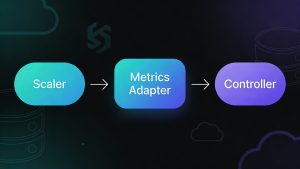A Distributed Operating System, or DOS, is a system that controls a set of independent computers and makes them look like one system to the user. It’s making several computers work together as one system, although they may be located physically elsewhere. This enables the completion of tasks efficiently, with minimal disturbances in case of node failure within the network.
Build from a powerful architecture of a system that allows for efficient, scalable, and fault-tolerant computing across more than one machine. It aims at giving the users all the advantages of resource sharing, increased fault tolerance, and scalability while offering the users the advantage of transparent interaction with the system.
Types of Distributed Operating System
There are many types of distributed operating systems. They can be classified into the following categories.
Network Operating System (NOS)
A Network Operating System connects multiple computers over a network but does not provide the full abstraction or transparency of a distributed operating system. It allows users to access resources across the network but typically requires manual configuration.
Clustered Operating System
In a clustered OS, a group of computers, typically called a “cluster,” collectively is utilized to create fault tolerance and load balancing. Tightly coupled and having single functions, such as web hosting or database management, these are usually systems.
Multitiered Operating System
It breaks down the architecture of computing into various layers or tiers, commonly applied for scaling and flexibility purposes. For instance, in the web services environment, one server might handle the presentation layer while another handles the logic layer and the third for the data layer.
Real-time Distributed OS
For systems in which the time response is a critical requirement, a distributed OS is employed. The job is accomplished within a specified timeframe; this is also critical in flight control or in medical systems, for example.
Uses of Distributed Operating Systems
Distributed Operating Systems are used in a variety of applications because they can manage the resources across many nodes efficiently. Some of the prominent applications are:
Cloud Computing: It allows to delivery of computing services (like servers, storage, databases) over the internet.
Distributed Databases: It allows big databases to be stored on several computers but hidden from the end user. High-Performance Computing (HPC): Resources provided for doing complex calculations usually required in scientific research, simulations, and computations.
Big Data Systems: Handling huge datasets that can be stored and processed across several servers, keeping it scalable.
E-commerce and Social Media Platforms: Scalable back-end architectures support millions of concurrent users.
Features of Distributed Operating System
A distributed operating system offers some features that distinguish it from traditional operating systems:
Transparency
Acting as a normal centralized system it hides the complexities of the underlying network, offering transparency in access, location, and migration of resources. Ensure the user is unaware of the distribution of resources and tasks across multiple machines.
This includes:
- Access Transparency: Users and applications can gain access to resources without knowing either the physical location of the resources (such as files or devices) or the details of the networks. Accessing a remote file appears to be the same as accessing a local file.
- Local Transparency: Users and applications do not know in which location the resources reside. For example, a file or service might be located on any node in the network, yet appear as if it resides on the local machine.
- Migration Transparency: Resources may be migrated from one node to another, without affecting the user’s view of the resource. Thus, dynamic load balancing and resource allocation become feasible.
- Replication Transparency: Users and applications are oblivious to the fact that resources have been replicated over many nodes for both fault tolerance and load balancing. They are exposed to a single logical resource.
- Concurrency Transparency: This ensures that many users or applications accessing a resource at once are not aware of each other, thus obtaining an unvaried view of the resource.
Scalability
The system can expand easily by supporting adding new machines without affecting the performance, necessary for growth in both size and capability. It includes:
- Horizontal Scalability: Adding more nodes to the system to increase capacity and performance. A scalable distributed operating system can efficiently integrate new nodes with minimal disruption.
- Vertical Scalability: Increasing the capacity of already existing nodes such as a hardware updation to increase load in the system. This is less probable in distributed scenarios but relevant.
Fault Tolerance
Distributed systems offer mechanisms to seamlessly handle failures and can tolerate individual machine failures, ensuring system reliability and availability even if some nodes fail. It includes:
- Redundancy: Duplicates critical components or services so that if one fails, another takes over. For example, one can duplicate the data or create backup nodes.
- Failover Mechanisms: This is the ability of a system to automatically switch to a set of backup systems or nodes once a failure is detected. In this way, service continuity and downtime are guaranteed.
- Fault Detection and Recovery: Mechanisms by which failures can be detected, and recovery initiated, such as reassigning tasks or recovering lost data to maintain system reliability.
Resource Sharing
Multiple computers can efficiently share their resources, including processing power, storage, and data across different machines. It includes:
- Distributed Resource Allocation: Coordination of resources, such as CPU time, memory, and storage, in various nodes and also load balancing in terms of allocating workloads among nodes for a smooth performance of the overall distributed system.
- Scheduling and Load Balancing: Techniques managing the execution of tasks and balancing the load so that none of the nodes becomes a bottleneck, hence providing optimal performance and resource usage.
- Resource Virtualization: It provides an abstraction to hide the implementation details of hardware resources from applications to present a virtualized view of resources across which applications could be made available uniformly.
Concurrency and Coordination
The system allows the simultaneous execution of processes, even across different machines and includes:
- Inter-Process Communication (IPC): Mechanisms for processes running on different nodes to communicate with each other. This can be in the form of message passing, remote procedure calls (RPCs), or other forms of communication.
- Synchronization: Techniques to ensure that processes or threads accessing shared resources do so in a coordinated manner, avoiding conflicts and ensuring data consistency. This may involve distributed locking or consensus protocols.
Security
One of the most critical feature that is widely popular is ensuring secure communication and data handling across many machines.
1. Authentication and Authorization
- Authentication: Authentication ensures that only authorized entities can access the system. Include username/password combinations, multi-factor authentication (MFA), and digital certificates.
- Authorization: This is essentially the definition and enforcement of permissions and access rights through methods such as access control lists or role-based access control.
2. Data Encryption and Integrity
- Data Encryption: This assumes confidentiality – both on transit in the case of sensitive data through the use of TLS/SSL and at rest using AES encryption.
- Data Integrity: Hashing (such as SHA-256) and checksums prevent data alteration and corruption during transmission and storage.
3. Access Control Mechanisms
- Access Control: Based on policies that determine access based on user roles, attributes, or other criteria, access control mechanisms govern how resources are accessed.
- Discretionary Access Control (DAC): Resource owners determine who can access their resources and what operations they can perform.
- Mandatory Access Control (MAC): Access decisions are made based on predefined policies, often enforced by the operating system or security software.
- Role-Based Access Control (RBAC): Access is granted based on the roles assigned to users, with permissions associated with each role.
Distributed vs Network Operating System
Although interchangeably used, Distributed Operating Systems and Network Operating Systems are quite dissimilar on the following counts:
Transparency: The complexity of the distributed environment is not visible to the user in a distributed OS, as it treats the system as one unit whereas a network OS makes the user manually intervene in the access and management of different machines to access their resources.
Resource Management: A distributed OS keeps track of the management of the resources throughout the entire network without leaving any lags, whereas a network OS allows each computer to work independently while carrying some type of communication between itself and other computers.
Fault Tolerance: Most times, a distributed OS comes with mechanisms for handling node failures; a network OS might be more vulnerable to a failure when faced with node failure.
Examples of Distributed Operating System
Several realistic distributed operating systems have been designed to provide efficient and reliable resource management. Some of them include:
Google’s Fuchsia OS: An OS that might work across several devices each having distributed processing capability.
Apache Hadoop: This is a distributed framework that gives the facility for storing and processing large data sets across clusters.
Plan 9 from Bell Labs: Distributed OS.
It has the reputation for being able to make the entire network of computers appear as one system.
Security in Distributed Operating Systems
Security in distributed systems is vital due to the distributed nature of resources, so there are several techniques adapted to maintain security:
Authentication and Authorization: Only authorized users can access resources.
Data Encryption: Protecting data from being accessed illegally within the networks during transfers.
Intrusion Detection Systems: Monitor the system for malicious activities.
Access Control: Controls access to sensitive information and resources according to the roles.
Advantages of Distributed Operating System
Improved Resource Utilization. Distributed operating systems can ensure more efficient resource usage because workloads are spread across multiple machines.
Scalability: There is no need to fundamentally alter the infrastructure to add more machines when the demand grows.
Fault Tolerance: A distributed OS will be inherently more resistant to hardware failure because there are data and processes, which can be replicated on many machines.
Cost-effective: The system could be cheaper, as it relies on commodity hardware and distributes workload, rather than investing in high-powered, central systems.
Disadvantages of Distributed Operating System
Complexity in Management: The management of a distributed system is complex and requires advanced knowledge of the system and network.
Security Concerns: The risks of unauthorized access, data breaches, and others are increased in a distributed operating system.
Network Dependency: A distributed OS is dependent on the network infrastructure, and if there is a failure in the network, then that can affect the whole system.
Latency Problems: Delays caused by communication among nodes can influence the system’s response in real-time applications.
This was all, best of luck with creating robust, innovative, and connected applications.



